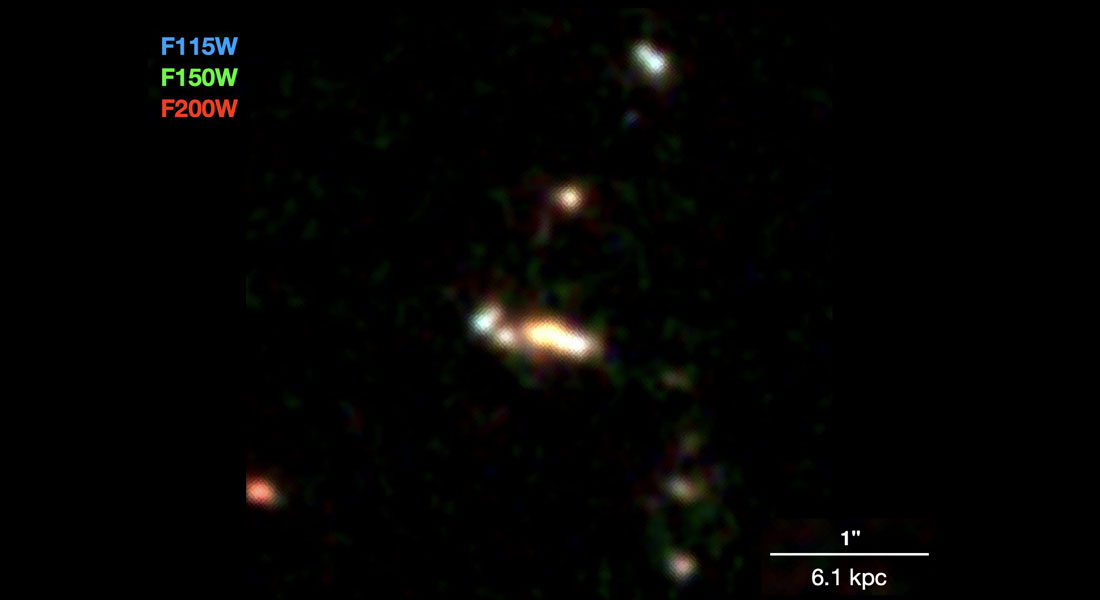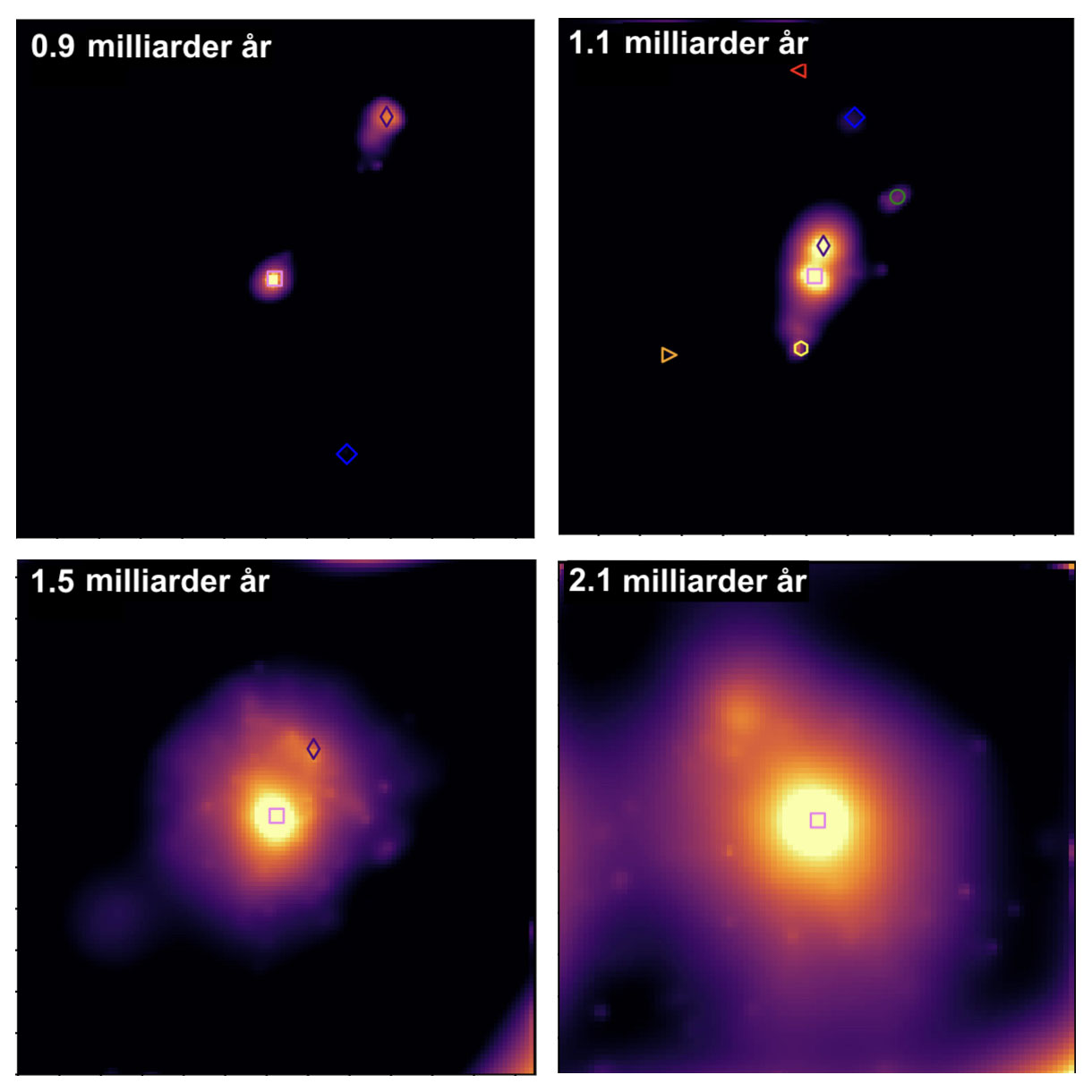James Webb Space Telescope Discovery
Clicking on each image will open the full resolution one. Try it!Clicking on "Raw images" image will yield all the relevant raw images.
Early galaxy formation caught in the act with JWST
GALAXY FORMATION: Astronomers from the Cosmic Dawn Center have unveiled the nature of the densest region of galaxies seen with the James Webb Space telescope in the early Universe. They find it to be likely the progenitor of massive, Milky Way-like galaxy, seen at a time where it is still assembling from smaller galaxies. The discovery corroborates our understanding of how galaxies form.
 A group of small galaxies, seen almost 13 billion years back in time, likely in the process of forming a massive galaxy. The colors are composed from three different infrared colors. The white, horisontal bar shows the scale of approximately 20,000 lightyears. Credit: Shuowen Jin et al. (2023).
According to our current understanding of structure formation in the Universe, galaxies form in a hierarchical manner, with small structures forming first in the very early Universe, later merging to build up larger structures. This is the prediction of theories and computer simulations, and is verified by observations of galaxies at various epochs in the history of the Universe.
To observe the very first structures assembling, we have to look as far back in time, and hence as far away, as possible. But these sources are both very small and very faint, and their detection requires advanced technologies.
In a new study, the early progenitor of what today will likely have evolved to a massive, Milky Way-sized galaxy, has been detected. This group of smaller galaxies, dubbed CGG-z5, was found through the observational program called "CEERS" with the James Webb Space Telescope, and is seen when the Universe was only 1.1 billion years old, 8% of its current age.
CGG-z5 was discovered using the code GalCluster, which was created by Nikolaj Sillassen, MSc student at the Cosmic Dawn Center (DAWN).
"I developed the software during my studies to detect this kind of structures, and now we applied it to data from the CEERS program," says Nikolaj Sillassen, who already found a similar but more nearby group while testing the software.
The brightest members of the galaxy group was discovered previously with the Hubble Space Telescope. But the CEERS program revealed new and smaller members.
"The other members of the group are both small and faint. Without the sensitivity and the spatial resolution of James Webb, we simply wouldn't be able to detect them," explains Shuowen Jin, Marie Curie Fellow at the Cosmic Dawn Center (DAWN) and lead author of the current study.
Exactly what is the "future" of the galaxy group CGG-z5 will be, is of course unknown. Rather than forming a single galaxy, it could be that the group evolves into a large cluster of galaxies at later times. Yet another possibility is that the members are in reality not so closely packed as it seems, but instead is a part of a filamentary structure that we just happen to view from one end to the other.
To distinguish between these scenarios, more precise observations involving the more time-consuming spectroscopy is needed. But in the meantime, help is available from computer simulations:
"In order to better understand the nature and evolution of CGG-z5, we searched for similar structures in large-scale, hydrodynamical simulations," says Aswin Vijiayan, Postdoctoral Fellow at the Cosmic Dawn Center who conducted the simulation analysis in the study. "We found 14 structures that match closely the physical properties of our observed group CGG-z5, and then traced the evolution of these structures through time in the simulations, from the early Universe to the present epoch.
A group of small galaxies, seen almost 13 billion years back in time, likely in the process of forming a massive galaxy. The colors are composed from three different infrared colors. The white, horisontal bar shows the scale of approximately 20,000 lightyears. Credit: Shuowen Jin et al. (2023).
According to our current understanding of structure formation in the Universe, galaxies form in a hierarchical manner, with small structures forming first in the very early Universe, later merging to build up larger structures. This is the prediction of theories and computer simulations, and is verified by observations of galaxies at various epochs in the history of the Universe.
To observe the very first structures assembling, we have to look as far back in time, and hence as far away, as possible. But these sources are both very small and very faint, and their detection requires advanced technologies.
In a new study, the early progenitor of what today will likely have evolved to a massive, Milky Way-sized galaxy, has been detected. This group of smaller galaxies, dubbed CGG-z5, was found through the observational program called "CEERS" with the James Webb Space Telescope, and is seen when the Universe was only 1.1 billion years old, 8% of its current age.
CGG-z5 was discovered using the code GalCluster, which was created by Nikolaj Sillassen, MSc student at the Cosmic Dawn Center (DAWN).
"I developed the software during my studies to detect this kind of structures, and now we applied it to data from the CEERS program," says Nikolaj Sillassen, who already found a similar but more nearby group while testing the software.
The brightest members of the galaxy group was discovered previously with the Hubble Space Telescope. But the CEERS program revealed new and smaller members.
"The other members of the group are both small and faint. Without the sensitivity and the spatial resolution of James Webb, we simply wouldn't be able to detect them," explains Shuowen Jin, Marie Curie Fellow at the Cosmic Dawn Center (DAWN) and lead author of the current study.
Exactly what is the "future" of the galaxy group CGG-z5 will be, is of course unknown. Rather than forming a single galaxy, it could be that the group evolves into a large cluster of galaxies at later times. Yet another possibility is that the members are in reality not so closely packed as it seems, but instead is a part of a filamentary structure that we just happen to view from one end to the other.
To distinguish between these scenarios, more precise observations involving the more time-consuming spectroscopy is needed. But in the meantime, help is available from computer simulations:
"In order to better understand the nature and evolution of CGG-z5, we searched for similar structures in large-scale, hydrodynamical simulations," says Aswin Vijiayan, Postdoctoral Fellow at the Cosmic Dawn Center who conducted the simulation analysis in the study. "We found 14 structures that match closely the physical properties of our observed group CGG-z5, and then traced the evolution of these structures through time in the simulations, from the early Universe to the present epoch.
 Four snapshots of the evolution of a simulated proto-galaxy from the "EAGLE" simulation, chosen to resemble the observed group CGG-z5. The brightness show the density of stars in the galaxies, and the symbols follow individual clumps of matter. In the 1.2 billion years that pass between the upper left and the lower right, the galaxies grows from a total stellar mass of 5 billion Suns to 65 billion Suns. Credit: A. Vijiayan and S. Jin.
Although the exact unfolding of the evolution of these 14 structures are different, they all shared the same fate: Roughly 0.5 to 1 billion years later, they merge to form a single galaxy which, by the time the Universe is half its current age, have masses comparable to our own Milky Way.
"Given the predictions of the simulations, it is therefore tempting to speculate that the CGG-z5 system will also follow a similar evolutionary path, and that we captured the process of small galaxies assembling into a single massive galaxy," Shuowen Jin concludes.
"Interestingly, the number of these early groups like CGG-z5 in a given volume of space is similar to the number of massive galaxies at later cosmic times", says Georgios Magdis, associate professor at DAWN and partaker in the study. "This makes merging groups appealing as the main progenitors of massive galaxies at later epochs".
Credit: Niels Bohr Institute
Four snapshots of the evolution of a simulated proto-galaxy from the "EAGLE" simulation, chosen to resemble the observed group CGG-z5. The brightness show the density of stars in the galaxies, and the symbols follow individual clumps of matter. In the 1.2 billion years that pass between the upper left and the lower right, the galaxies grows from a total stellar mass of 5 billion Suns to 65 billion Suns. Credit: A. Vijiayan and S. Jin.
Although the exact unfolding of the evolution of these 14 structures are different, they all shared the same fate: Roughly 0.5 to 1 billion years later, they merge to form a single galaxy which, by the time the Universe is half its current age, have masses comparable to our own Milky Way.
"Given the predictions of the simulations, it is therefore tempting to speculate that the CGG-z5 system will also follow a similar evolutionary path, and that we captured the process of small galaxies assembling into a single massive galaxy," Shuowen Jin concludes.
"Interestingly, the number of these early groups like CGG-z5 in a given volume of space is similar to the number of massive galaxies at later cosmic times", says Georgios Magdis, associate professor at DAWN and partaker in the study. "This makes merging groups appealing as the main progenitors of massive galaxies at later epochs".
Credit: Niels Bohr Institute
 More JWST-DAWN data (unofficial)
More JWST-DAWN data (unofficial)